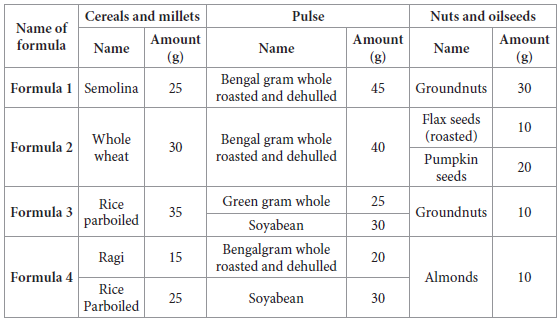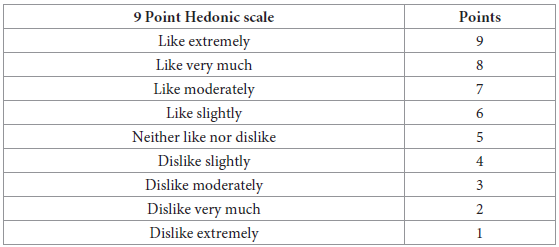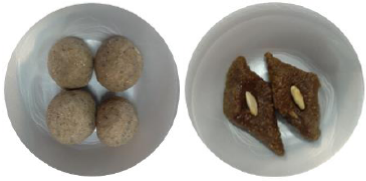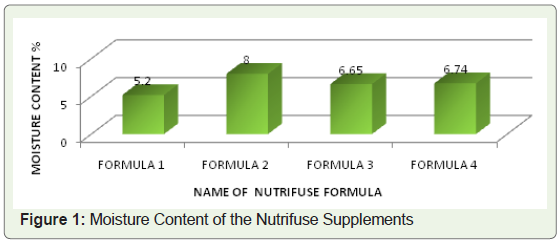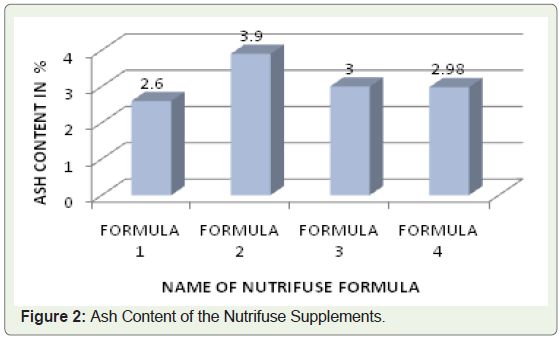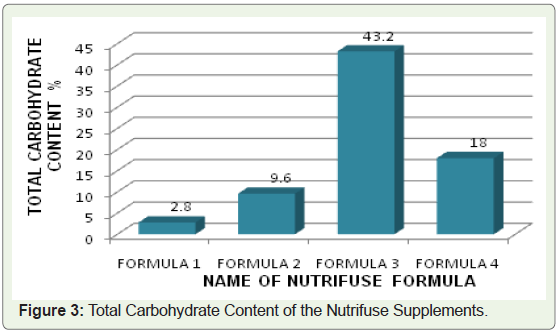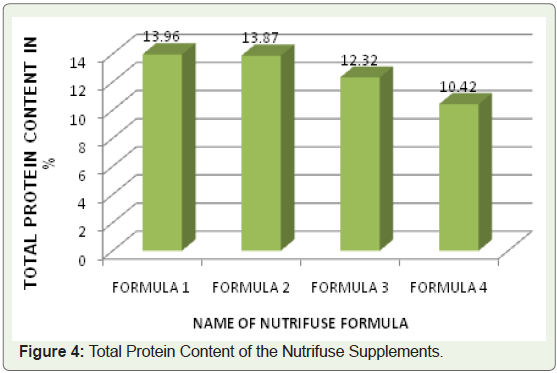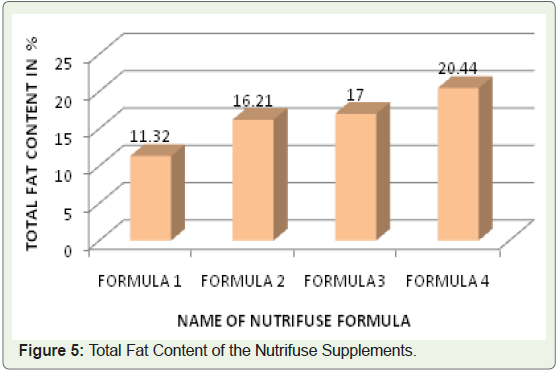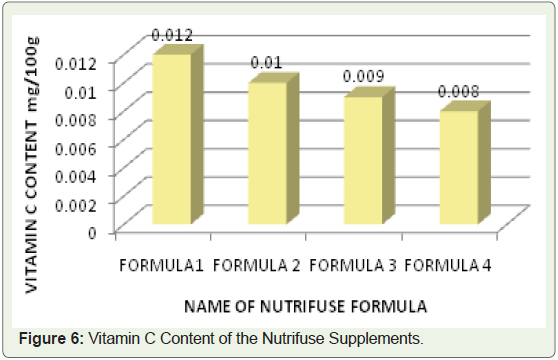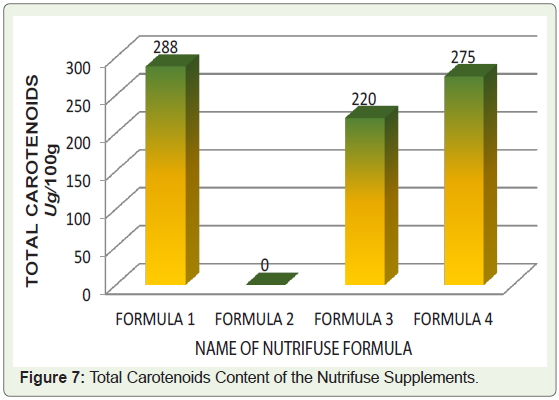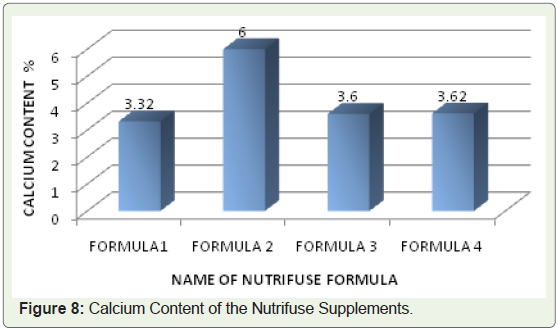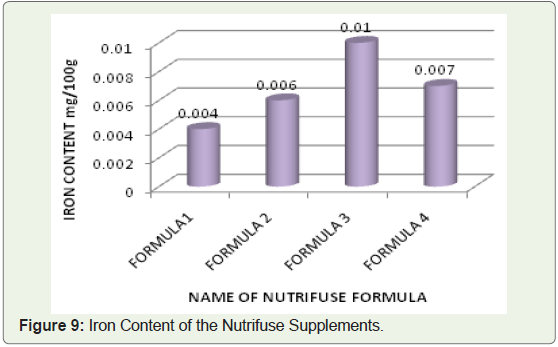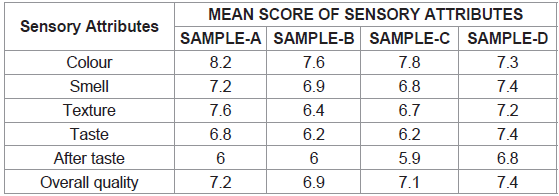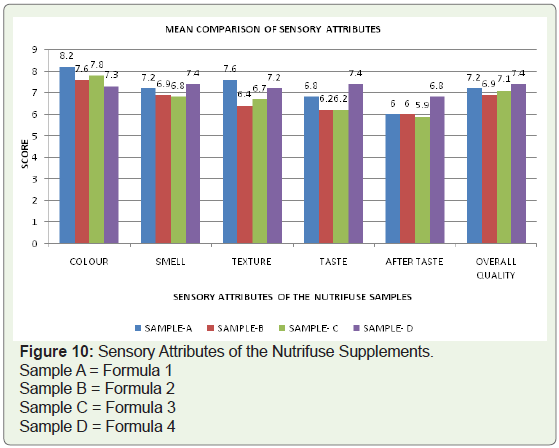Research Article
Formulation and Preparation of Nutrifuse Supplement for Mother and Child
Basu A, Nandi S, Hota S and Chatterjee A*
Laboratory of Food Chemistry & Microbiology, Food & Nutrition Division, Department of Home Science, University of Calcutta,
Kolkata
*Corresponding author: Chatterjee A, Laboratory of Food Chemistry & Microbiology, Food & Nutrition Division, Department of
Home Science, University of Calcutta, Kolkata; E-mail: annalakiicb@gmail.com
Article Information: Submission: 08/02/2023; Accepted: 24/03/2023; Published: 29/03/2023
Copyright: © 2023 Basu A, et al. This is an open access article distributed under the Creative Commons Attribution License,
which permits unrestricted use, distribution, and reproduction in any medium, provided the original work is properly cited.
Abstract
Supplementary foods are special formulations in ready-to-eat or milled form, beyond normal ration of home diets with modified energy, protein, fat or
micronutrient content. It helps to improve nutritional status or prevent nutritional deterioration of the food insecure vulnerable population, people suffering
from diseases, cope up with long and short term food shortage, improve school performance etc. Integrated Child Development Services Scheme among
multidimensional services provide supplementary foods with an aim to meet the gap of 1/3rd of total calories as well as ½ of the protein requirements for
children below 6 years, pregnant, lactating women and adolescent girls. The study was focused with interest to prepare suitable Nutrifuse supplement powders
of low and moderate cost i.e two gluten based and two gluten free (gluten sensitivity) for pregnant, lactating women, children up to 6 years of age in the weaker
sections of society ranging from Rs 14.92 to Rs29.3 /100g. The supplements developed were good source of protein (10.42 g to 13.96 g), fat (11.32to
20.44 g) and calcium (3.32 to 6 g) per 100g with an overall acceptability score between 6.9 to 7.4. Thus the 4 formulations of Nutrifuse supplement can be given
as supplementary foods and can be used in future product development process.
Keywords
Almonds; Bengal gram; Groundnuts; Nutrifuse supplements; Ragi; Semolina; Soyabean
Introduction
urbanization and rapid rise in number of
working women in recent years has led to a drastic change in the
growth of the convenience foods in terms of quality and quantity,
products available in the market, the packaging and the processing
technologies involved. Convenience foods in the market vary from
ready-to-eat dry products, frozen foods, various mixes, snacks [1].
Nutrimix powder is an instant type of food that helps to achieve
recommended nutrient requirement of the people with busy lifestyle
in diverse age groups. Nutrimix is a complete energy, protein, mineral,
vitamin and fibre rich supplement that can properly balance the
nutrient levels thereby helping to support normal blood composition,
immune function and overall performance [2]. Government of
India has launched and implemented various schemes to combat
malnutrition but India being a developing country, malnutrition pose
serious problems among pregnant women, lactating women, children
and adolescents. Illiteracy, low socio economic status in addition
to multiple child births, early marriage combined with adolescent
pregnancy, reluctance for IFA tablets, deworming tablets, lack of
kitchen garden practices, depriving the infants from colostrum,
poor complementary feeding practices, poor hygiene practices, are
responsible for under nutrition of the above-mentioned age groups
specially stunting, followed by underweight and wasting in children.
Nutrimix yields 16.66% of Protein, 11.70% of Fibre, 13.13% of Fat,
63.71% of Carbohydrates and 6.99% of Moisture [2]. Proximate
analysis of Sarbottam pitho showed that the content of protein,
fat, carbohydrate, crude fiber and total ash were 12.73%, 9.30%,
69.23%, 2.61% and 2.89% respectively [3]. Calcium-rich Nutrimix
flour has Moisture (7.7±0.2%), Calcium (398.2±0.89 mg), Iron
(4.8±0.14 mg), Protein (16.4±0.99%), Carbohydrates (65.6±0.22 g),
Energy Value (389.29±1.24 Kcal), Crude Fat (6.80±36%) and Crude
fibre (2.04±0.30%) [4]. Pearl millet based weaning foods contains
moisture of 3.73±0.02%, protein, fat, carbohydrate, ash and crude
fiber of 15.32±0.06%, 1.96±0.07%, 79.58±0.06 %, 2.02±0.02 % and
1.12±0.10% and iron, vitamin A and ß-Carotene content of the final product are 15mg, 393μg and 30.62μg per 100g respectively [5]. Nutrimix supplement has protein content 28%, fibre 14%, fat 3%,
starch 43% and moisture 12% [6]. The Nutri- mix supplementation
for 90 days has helped to improve wasting status of children of 9-36
months of age [7].
The study was aimed with interest to prepare supplementary food
for socioeconomically underprivileged community. Proximal and
sensory characteristics evaluation was also the focus of the present
study.
Materials & Methods
Sample collection and formula development:
Raw ingredients were purchased from Ballygunj market of
Kolkata, India and 4 different types of formula were developed by
roasting depending on allergic sensitivity (gluten sensitivity) to
different foods and for better nutrition and affordability of the target
audience.• Formula 1- Low Cost Gluten Based Formula
• Formula 2 - Moderate Cost Gluten Based Formula
• Formula 3- Low Cost Gluten Free Formula
• Formula 4 - Moderate Cost Gluten Free Formula
Proximate analysis:
Determination of Moisture Content
10g of sample was used for determination of moisture content.
Oven drying method was used for this purpose [8].
Moisture (%) = Weight of sample – (Weight of petridish after
drying - Weight of petri dish)/Weight of sample X 100Determination of Ash Content
5 g of sample was used for determination of ash content. Muffle
furnace was used for ashing the samples [8].
% Ash (Dry basis) = Weight after ashing/ Weight before ashing
X 100
Determination of Carbohydrate Content
Total carbohydrate content of the samples was measured by
Anthrone method [9]. During sample preparation, the supernatant
of the sample solutions after centrifugation at 3000 rpm were 40 times
serial diluted and from it 0.5ml and 1 ml collected and distilled water was added for volume make up to 1ml and this aliquot was used for
the analysis.
Determination of Total Protein Content
Total protein content of the samples was measured using Kjeldahl
method [10]. For this purpose 50 g of the 4 sample mixes were
weighed and sent for laboratory testing.
Determination of Total Fat Content
Total fat content of the moisture free samples were estimated
using Soxhlet extraction method [11].
Determination of Micronutrient Content:
Determination of Vitamin C Content
Estimation of Vitamin C was done by 2,6 Dichlorophenol
indophenols (DCIP) dye titration method [12]. 5g sample dissolved
in 50ml (3% Metaphosphoric acid) and the solution filtered in
a conical flask through funnel with the help of muslin cloth. 10ml
filtrate transferred to 100 ml conical flask. To it equal volume of
distilled water added, titration done with dyestuff until pink colour
appeared which was stable for 15 seconds.Determination of Total Carotenoids
Total carotenoids measured by spectrophotometry [13,14].
Homogenized sample after centrifugation were collected in
volumetric flask after being filtered through funnel whose mouth was
covered with glass wool.
Chlorophyll a = 11.75 X A662 - 2.35 X A645
Chlorophyll b = 18.61 X A645 - 3.96 X A662
Total Carotenoids (ug/ml) = 1000 X A470 - 2.27 X Chlorophyll a –
81.4 X Chlorophyll b/ 227
Determination of Calcium Content
Calcium content of the samples was measured using EDTA
Titrimetric method [15].
Determination of Iron Content
Iron was estimated by Thiocyanate method [16].
Sensory analysis:
Sensory evaluation was done using 9 point Hedonic scale.
Formula 1, Formula 2, Formula 3, Formula 4 (Marked with random
alphabets (A,B,C,D). Samples introduced once in front of 10 sensory
panel members and were asked to give scores to each sample on the
basis of colour, smell, texture, taste, after taste, overall quality. There
was intake of drinking water between 2 consecutive samples.Product development:
Using the best formula two sweet items was prepared. Required
amount of formula mix was added to 2 tablespoon of oil and stirred
till a baking flavor developed. To this equal quantity of sugar/ jaggery
was added and mixed properly. Milk powder and powdered coconut
were added to enhance the taste. Water was added further and a thick
consistency was prepared. Appropriate shapes were made which were
suitable for preparing laddus and barfis. For laddu preparation sugar
was used and for barfi jaggery was used.Results & Discussion
Proximate Analysis:
Moisture Content
High moisture content of Formula 2 revealed that it had the least
shelf life among the others. Moisture content of Formula 4 was almost
similar to that of nutrimix powder with oats flour, soybean powder,
ragi, chia seeds, jaggery. It is 6.99±4.27% [2]. Nutrimix with Finger
Millet, Semolina, Green Gram, Amaranth Seeds and Gingelly Seeds
has greater moisture content 7.7±0.2% in comparison to Formula 1
[4]. Total bacterial and fungal count of the formulas were within the
safer limits for at least 30 days as they were kept in airtight packages
and were stored properly (Figure 1).Ash Content:
Ash content of the formulas indicated the concentration of
minerals present in them. Ash content of formula 4 was almost
similar to nutrimix powder made from finger millet, green gram,
bengal gram, groundnuts which is 2.85 + 0.05 g [17]. Nutrimix with
Finger Millet, Semolina, Green Gram, Amaranth Seeds and Gingelly
Seeds has lesser Ash content 2.4±0.34% than that of Formula1[4] (Figure 2).Carbohydrate content:
Carbohydrate content of Formula 3 was highest followed
by Formula 4 while the lower carbohydrate content of the other
two formulas might be due to manual error in the experiment.
Carbohydrate content of Formula 4 was much less than carbohydrate
content of nutrimix powder with oats flour, soybean powder, ragi and
chia seeds, jaggery which is 63.71±27.53% [2]. Carbohydrate content
of Formula 1 was much lesser than nutrimix powder from finger
millet, green gram, bengal gram , groundnuts which is 69.82 + 2.29g
[17] (Figure 3).Total Protein Content:
Formula 1 had the highest protein content among the 4 formulas,
was slightly lesser than Protein of Nutrimix with Finger Millet,
Semolin, Green Gram, Amaranth Seeds and Gingelly Seeds which
is16.4±0.99% [4]. Formula 4 had the least protein content but the quality of protein was better due to presence of well balanced amino
acids in ragi and soyabean. It was lesser than nutrimix powder made
from finger millet, green gram, bengal gram, groundnuts which is
15.03 + 1.40 g [17] (Figure 4).Total fat content:
Total fat content of Formula 4 was highest due to presence of
almonds. Fat content of Formula 4 was greater than Fat of nutrimix
powder with oats flour, soybean powder, ragi and chia seeds, jaggery
which is 13.13% [2]. Formula 1 had higher fat content than nutrimix
made from finger millet, green gram, bengal gram, groundnuts which
is3.68 + 0.25g [17] (Figure 5).Determination of Micronutrient Content:
Vitamin content
Vitamin C content of the samples depends upon the rate of
oxidation of Vitamin C present in the samples. Vitamin C content of
the Formula 1 was the highest among the others Figure 6.Total carotenoids:
Total Carotenoids content of Formula 1 and Formula 4 were
higher than Vitamin A content of nutrimix powder made from finger
millet, green gram, bengal gram, groundnuts which is15.82 ± 0.59 (μg) [17] (Figure 7).Calcium content:
Calcium content of Formula 4 was higher than of nutrimix powder
made from finger millet, green gram, bengal gram, groundnuts which
is 284.78 ± 2.20 mg [17]. Calcium content of Formula 1 was higher than Nutrimix with Finger Millet, Semolina, Green Gram, Amaranth
Seeds and Gingelly Seeds which is 398.2±0.89 mg [4] (Figure 8).Iron content:
Iron content of the samples was much below than the expected
level. It might be due to presence of interfering factors which gave
false results during the experiment. Iron content of nutrimix powder
4.8±0.14 mg with Finger Millet, Semolina, Green Gram, Amaranth
Seeds and Gingelly Seeds is higher than that of Formula 1 [4] (Figure 9).Likewise iron content of nutrimix powder made from finger millet,
green gram, Bengal gram, groundnuts have iron content of 4.39 ± 0.43
mg much higher than Formula 4 [17].
Sensory characteristics:
Among the 4 formulas mean scores of sensory attributes were
obtained from average scores given by 10 panelists. Colour score
of Formula 1 was highest followed by Formula 3,2 and 4. Scores
regarding Smell of Formula 4 was highest followed by Formula
1, Formula 2 whereas Formula 3 scored the least. Score regarding
Texture of Formula 1 was highest followed by Formula 4, 3 and
Formula 2 scored the least. Scores of Taste of Formula 4 highest
followed by Formula 1 and equal score of Formula 2 and 3. Scores
of after taste of Formula 4 was highest followed by followed by equal
score of Formula 1 and 2 whereas Formula 3 scored the least. In
overall quality Formula 4 ranked the highest followed by Formula 1,
3 whereas the score for Formula 2 was the least (Figure 10).Thus the best formula among the 4wasFormula 4 or moderate cost
gluten free formula due to greater score in overall quality. Formula 1
or low cost gluten based formula was ranked after it.
Cost Analysis:
The cost of the formulas was calculated according to the quantity
of ingredients used in 100 g mixture for the specific formulas. Cost
effectiveness of Formula 3 or low cost gluten free formula is greater
(Rs 14.92/100 g) than Formula 1or low cost gluten based formula
(Rs16.1/100g). Similarly cost effectiveness of Formula 4 or moderate
cost gluten free formula is greater (Rs23.59/100g) than that of Formula 2 (Rs29.3/100 g) or moderate cost gluten based formula.Developed product:
The sweets like laddus and barfis developed from the best formula
or formula 4 had good colour, shape, texture and were appealing to the
eyes. The taste of the developed products was accepted by pregnant,
lactating women as well as children. The products developed had a
good after taste. So the products were nutritious as well as palatable
and they gained psychological acceptance. Apart from that addition
of jaggery to the barfis had enhanced the energy as well as iron
content of the diet.Discussion
Complementary foods are unique preparations in ready-to-eat or
milled form that go beyond and beyond the typical home diets’ serving
sizes and have altered calorie, protein, fat, and micronutrient contents.
Socioeconomically underprivileged community was targeted for better
nutrition. Nutritionally, Formula 4 consists of Parboiled rice, Ragi,
Soya bean, Bengal gram, Almonds. On the other hand, Formula 1 was
prepared using different components from the food group composed
of Semolina, Bengal gram and Groundnuts. From the view point of
macronutrient content, it is slightly lower in quantity but the quality
is better due to presence of well-balanced polysaccharides and amino
acids required for the growth. Micronutrient content especially iron
and calcium of the prepared Formula indicates that it will be a good
source for bone and brain development of the target group. Due to
the presence of groundnut in Formula 1, it could be a good source for
Zinc supplementation required for brain development of preschool
and school going children. Both the formulae could be a good source
for Vitamin A supplement as the presence of Total Carotenoids is
higher than the products that are available in the market. The shelf
life of both the Formulae is better than that of other supplementary
powders available in the market due to their less moisture content.
Conclusion
The best formula mix is Moderate cost gluten free formula. It
includes parboiled rice which is a good source of energy, carbohydrate,
B vitamins. The protein in ragi is well balanced, and content of
lysine, methionine, threonine, and valine is more. Soya bean and
Bengal gram are good source of essential nutrients especially protein,
dietary fiber, iron, manganese, phosphorus and several B vitamins,
including folate. Almond is nutrient dense with rich source of vitaminE,
calcium, copper, iron, magnesium, manganese, phosphorus,
and zinc, moderate source of B vitamins thiamine, vitamin B6,
and folate, choline, and potassium, substantial dietary fiber,
the monounsaturated fat, oleic acid, and the polyunsaturated
fat, linoleic acid. Although the gluten free formulas are meant for
people with gluten sensitivity it is not suitable for people having
allergy to soy protein, Almonds, Groundnuts. Thus, soyabean can
be replaced with Bengal gram, green gram or a mixture in suitable
ratios. Groundnuts and almonds can be replaced with sesame seeds
and flax seeds. Although Formula 4 is the most suitable formula but
the cost of preparing the mix is much higher. Thus Formula 1 or Low-costgluten-based formula consisting of semolina, bengal gram,
groundnuts are also source of ample quality of nutrients and thus
also can serve as suitable supplement powder keeping in mind for the
affordability of the target audience.
Acknowledgement
Dr. Ajoy Mistry, Humanity Trust(Kolkata) for collaboration with
Laboratory of Food Chemistry and Microbiology for completion of
this project.

